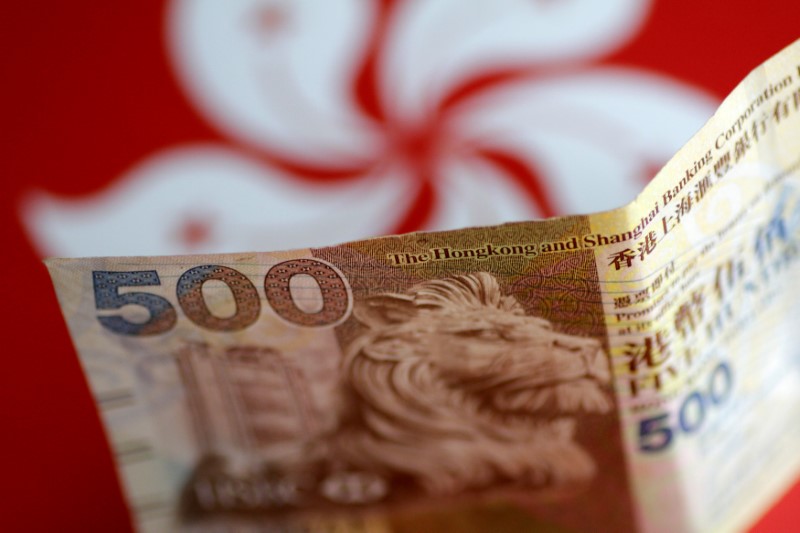 © Reuters. FILE PHOTO: Illustration photo of a Hong Kong dollar note
© Reuters. FILE PHOTO: Illustration photo of a Hong Kong dollar noteBy Donny Kwok and Twinnie Siu
HONG KONG (Reuters) – Hong Kong’s central bank intervened in the market for the first time since 2015 after its currency hit the weaker end of its trading range, nudging up a key lending rate that could push borrowing costs higher.
“I reiterate that the HKMA will buy Hong Kong dollars (HKD) and sell U.S. dollars at 7.85 level to ensure that the HKD exchange rate will not weaken beyond 7.8500,” Norman Chan, chief executive of the Hong Kong Monetary Authority (HKMA), said in a statement.
In U.S. trading hours, the HKMA stepped into the currency market and bought HK$3.038 billion ($387.01 million) in Hong Kong dollars on Friday, as the local currency hit the weaker end of its trading range.
Earlier in the session, the central bank bought HK$2.442 billion ($311 million) of Hong Kong dollars. On Thursday, it bought HK$816 million from the currency market.
This was the first time since the current trading band was introduced in 2005 that the weak-side convertibility undertaking (CU) at 7.85 to keep the Hong Kong dollar closely pegged to the U.S. currency had been triggered.
The HKMA said the undertaking was triggered in London trading hours.
The Hong Kong dollar touched the lower end of the central bank’s trading band target as the interest rate gap between the greenback and the local currency widened.
As the former British colony pegs its currency to the dollar, its money market rates should mirror those of its U.S. counterpart, but the gap has now widened to more than 117 basis points since the Federal Reserve started raising interest rates from ultra-low levels adopted during the 2008 financial crisis. Hong Kong’s markets have remained flush with excess cash, keeping a lid on Hong Kong dollar interest rates.
PRESSURE ON HK DOLLAR
Most market participants do not see the current bout of weakness as a threat to the currency peg even though high liquidity stemming from Chinese and overseas investment into Hong Kong’s domestic markets is anchoring short-term interest rates and putting downward pressure on the currency.
The Hong Kong dollar is pegged at 7.8 to the U.S. dollar, but can trade between the high and low limits of 7.75 and 7.85. Under the currency peg, the HKMA is obliged to intervene when the Hong Kong dollar hits 7.75 or 7.85 to keep the band intact.
The currency traded at 7.8499 against the U.S. dollar at 1655 GMT.
“The HKMA is fully capable of maintaining the stability of the HKD and managing large scale capital flows. There is no need to be concerned,” Chan said.
BofA Merrill Lynch forecasts the Hong Kong dollar will stay around 7.85 per U.S. dollar for the rest of 2018.
The latest intervention, which brings the total amount of local currency bought to HK$6.296 billion, will reduce the aggregate balance – the forecast sum of balances on clearing accounts maintained by banks with the HKMA – to HK$173.482 billion on April 17, according to Reuters data.
HIBOR CLIMBS
Three-month interbank rates in Hong Kong
“Hibor firmed up after the intervention and it’s clear that Hibor is trending up in a gradual and steady manner,” said Alan Yip, FX market analyst at Bank of East Asia.
BofA Merrill Lynch forecasts three-month Hibor will rise to 1.60 percent by year-end and the HKMA would have to buy HK$80 billion of Hong Kong dollars to push up Hibor meaningfully.
Hong Kong has raised its base rate charged through its overnight discount window twice in the past few months in lockstep with the Fed. The base rate now stands at 2.00 percent.
The city’s major banks have left their prime rates unchanged, although the HKMA has said it expects them to raise rates gradually.
Hong Kong’s U.S. dollar peg has forced it to keep monetary policy loose in recent years in step with the United States, but rock bottom interest rates have only fueled the city’s real estate prices that are already among the highest in the world.
The monetary authority last intervened in the market in 2015, selling Hong Kong dollars as the local currency repeatedly hit the strong end of its trading band.
($1 = 7.8496 Hong Kong dollars)
Source: Investing.com





























